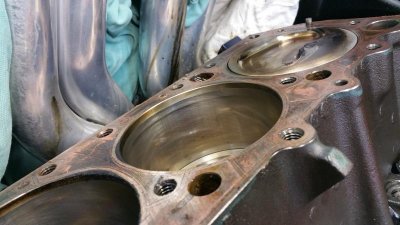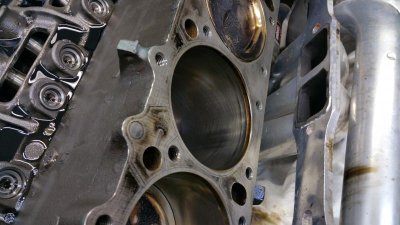Brewzer67
Well-Known Member
I am hoping the collective can help me out (or at least calm my paranoia). I have a 528" that now has 1500 miles on a fresh rebuild. I have the heads off as I prepare to switch over to a roller cam and the new Trick Flows so before I put the new heads on and button things up I want to make sure I am making the right call by not going back through the shortblock.
Here are the 3 concerns:
1. The heads I previously had were some well ported Stage VI's that I bought used off eBay. After I bought them, I sent them to my head porter to look at to make sure there was no work needed before using them. He said all looked good, put new Teflon seals on and put a little spit and polish on the spacer port work (and picked up a few more CFM by working them a little more where they met up with the manifold). At the time I bought them I was just sending out the short block to a local Mopar specialist. Once I was given the all clear on the heads I gave them to him and he put the whole motor together. After dropping it in the car and breaking it in, I unfortunately had tons of oil smoke. Upon examination, three cylinders on the even bank were dumping lots of oil into the headers. Eventually the cylinders all started to come around so I thought I was good and it was just the rings being stubborn. After 1500 miles it still huffed some but I wrote it off as residual deposits still burning off. I just pulled the heads today and found a few anomalies. All cylinders except 1 (not just the one's on the even bank) show that they have pulled a lot of oil in. Seven cylinders show lots of signs of oil on the back sides of the valves, so I think it is being pulled past the guides. The guides were actually a little tight when checked by the porter and new Teflon seals installed so I don't know why they are pulling so much oil. I do know that when I am driving under steady state on the freeway I am pulling 25" of vacuum which seems excessive. When I decelerate, it pegs my vacuum gauge. I think this is likely the cause for pulling so much oil past the guides. Am I correct in this thinking? What can I do to fix the heads? Is there a better seal I can use? Is this common with the Stage VI's? I know it can be if the spring pockets aren't relieved, but mine have been. I want to re-use them on a 448" short block I have for a different project so I am looking for any advice on how I can fix this? Vacuum pump maybe?
2. Looking at the lifters they show an odd wear pattern. It is apparent they are definitely rotating in the bores (which were align honed but un-bushed at the time of the rebuild). The lifter faces all look good and lobes also look great.The wear pattern on a few of them shows what almost looks like striped vertical wear patterns. Smooth with no grooves or scratches, but definitely bands of wear. Any ideas? I'll try to get a picture to add to the post tomorrow.
3. I am also concerned about the wear pattern on the cylinders themselves because they all show more pronounced wear at the spot the where the two ring lands are at TDC then I have ever seen on any of my previous motors. I am also concerned by the vertical scuffing in the 2nd picture. It can't be felt with a fingernail but it seems to me to be a little more wear than I am used to seeing with that little of mileage. It should also be noted that this wear pattern is most prevalent on the one good cylinder. This is my first stroker this big (4.375 stroke) so it might be normal. Any input would be appreciated.


Here are the 3 concerns:
1. The heads I previously had were some well ported Stage VI's that I bought used off eBay. After I bought them, I sent them to my head porter to look at to make sure there was no work needed before using them. He said all looked good, put new Teflon seals on and put a little spit and polish on the spacer port work (and picked up a few more CFM by working them a little more where they met up with the manifold). At the time I bought them I was just sending out the short block to a local Mopar specialist. Once I was given the all clear on the heads I gave them to him and he put the whole motor together. After dropping it in the car and breaking it in, I unfortunately had tons of oil smoke. Upon examination, three cylinders on the even bank were dumping lots of oil into the headers. Eventually the cylinders all started to come around so I thought I was good and it was just the rings being stubborn. After 1500 miles it still huffed some but I wrote it off as residual deposits still burning off. I just pulled the heads today and found a few anomalies. All cylinders except 1 (not just the one's on the even bank) show that they have pulled a lot of oil in. Seven cylinders show lots of signs of oil on the back sides of the valves, so I think it is being pulled past the guides. The guides were actually a little tight when checked by the porter and new Teflon seals installed so I don't know why they are pulling so much oil. I do know that when I am driving under steady state on the freeway I am pulling 25" of vacuum which seems excessive. When I decelerate, it pegs my vacuum gauge. I think this is likely the cause for pulling so much oil past the guides. Am I correct in this thinking? What can I do to fix the heads? Is there a better seal I can use? Is this common with the Stage VI's? I know it can be if the spring pockets aren't relieved, but mine have been. I want to re-use them on a 448" short block I have for a different project so I am looking for any advice on how I can fix this? Vacuum pump maybe?
2. Looking at the lifters they show an odd wear pattern. It is apparent they are definitely rotating in the bores (which were align honed but un-bushed at the time of the rebuild). The lifter faces all look good and lobes also look great.The wear pattern on a few of them shows what almost looks like striped vertical wear patterns. Smooth with no grooves or scratches, but definitely bands of wear. Any ideas? I'll try to get a picture to add to the post tomorrow.
3. I am also concerned about the wear pattern on the cylinders themselves because they all show more pronounced wear at the spot the where the two ring lands are at TDC then I have ever seen on any of my previous motors. I am also concerned by the vertical scuffing in the 2nd picture. It can't be felt with a fingernail but it seems to me to be a little more wear than I am used to seeing with that little of mileage. It should also be noted that this wear pattern is most prevalent on the one good cylinder. This is my first stroker this big (4.375 stroke) so it might be normal. Any input would be appreciated.


















